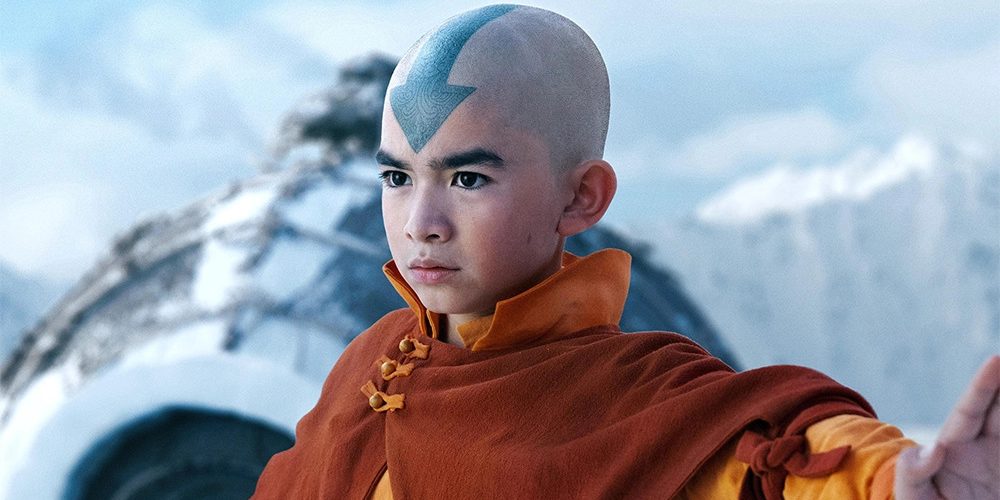Based on the eponymous animated TV series that ran from 2005 to 2008, Netflix’s ‘Avatar: The Last Airbender‘ is an action-adventure fantasy series created by Albert Kim. Set in a war-torn realm where some of the inhabitants have the ability to manipulate or control one of the four classical elements — water, earth, fire, or air. However, a young boy named Aang, who is also known as the Avatar, is capable of bending not one or two elements, but all of them at once. Given his spiritual capabilities, he is the chosen one to bring balance and peace to the world from the militaristic desires of the Fire Nation.
With the assistance of his new companions — Katara and Sokka — Aang embarks on a mission to master all the four elements and go up against the exiled prince of the Fire Nation — Zuko — who is hell-bent on capturing Aang and regain his honor. Led by the compelling performance of Gordon Cormier, the Netflix show also features an ensemble cast in supporting roles, including Kiawentiio, Ian Ousley, Dallas Liu, Daniel Dae Kim, Paul Sun-Hyung Lee, Ken Leung, Yvonne Chapman, Tamlyn Tomita, and Elizabeth Yu. Not only does the fantastical setting where all the action unfolds keep the viewers engaged and glued to their seats through each episode, but it also provides a unique visual spectacle that raises certain questions regarding its real-life locations.
Where is Avatar: The Last Airbender Filmed?
‘Avatar: The Last Airbender’ is filmed in British Columbia, specifically in Metro Vancouver. Under the working titles ‘Trade Winds’ and ‘Blue Dawn,’ the principal photography for the inaugural iteration reportedly got underway in mid-November 2021. The filming unit took a break during the Christmas season, which was further extended due to the surge of the Omicron variant. Finally, after more than seven months, it was wrapped up in June 2022. Reports also suggest that the cast and crew returned to the set in September 2022 for the shooting of some additional scenes.
Vancouver, British Columbia
The taping of ‘Avatar: The Last Airbender’ takes place in several areas of Metro Vancouver, also known as Greater Vancouver, in British Columbia. For shooting, the cast and crew visit the the southwestern part of the province, particularly the port city of Vancouver in the Lower Mainland region. To fulfill the visual effects requirement for the purpose of immersive world-building of season 1, Netflix teamed up with Pixomondo, an Academy and Emmy award-winning VFX and Virtual Production company.
According to reports, the custom-built stage is 84 feet across and 28 feet in height, spans 23,000 square feet, and features 3,000 LED panels. The studio employed its world-class expertise in the creation of a state-of-the-art LED soundstage for the live-action adaptation. It eventually earned a Guinness World Record for the world’s largest LED stage. Josh Kerekes, Virtual Production Supervisor and Head of Production at Pixomondo, talked about the extraordinary feat in an interview with IGN. He said, “It’s a fantasy travel show, and every episode it seems we’re almost in a different bio.”
Elaborating on how the team manages to build “most amount of environments,” each with “different feels and moods,” he added, “We’re going from the South Pole to mountains, to tropical seaports, to ships at sea, to flying on a sky bison, sometimes all within the same week.” Kerekes further added that the team created about 26 sets with a vast number of scenarios, probably around 100, such as the state of Northern Water Kingdom before the attack as well as the destruction it suffers during and when it is about 90% wrecked. For taping sequences involving Appa, the team utilizes huge props such as a rig to double up as the sky bison.
Apart from Vancouver, the town of Burnaby, located in the heart of the Burrard Peninsula, also serves as one of the shooting sites for the show. Interestingly, aside from seasoned martial artists Ian (Sokka) and Dallas (Zuko), many actors underwent weeks of training in the art form to do justice to their respective characters. In another interview, showrunner Albert Kim stated, “Each bending discipline is based on a different martial arts style. And so, they all had to learn their own styles as well as get familiar with the other ones… All the guest stars that came on too who were doing bending, they also went through their own versions of training.”
Read More: Shows Like Avatar: The Last Airbender

